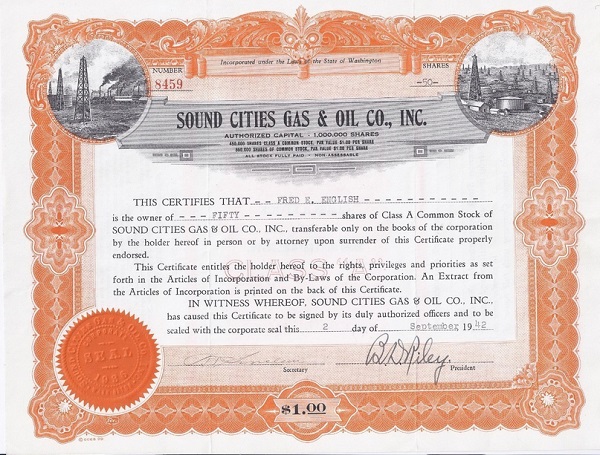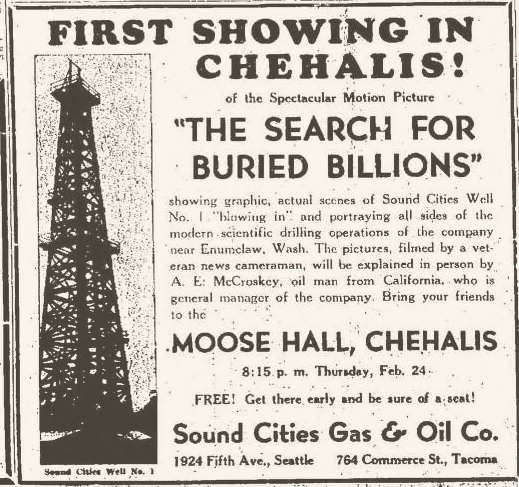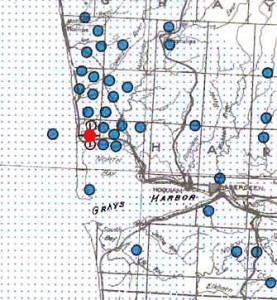Washington state had never experienced significant commercial oil production until a wildcat well drilled by the Sound Cities Gas & Oil Company during the Great Depression. The company found just enough oil to instill oil fever about 40 miles south of Seattle.
Although West Coast oil seeps had led to major California oil discoveries, Washington (and Oregon) geology had frustrated exploration companies for decades. Sound Cities Gas & Oil, which had offices in Seattle and Tacoma, drilled near coal seams with seeps already producing flames.

Despite its advertised “modern scientific drilling operations” and exploration efforts near natural seeps, success eluded Sound Cities Gas & Oil Company.
Using a cable-tool drilling rig near the town of Enumclaw, the company drilled the Bobb No. 1 well seeking a hillside anticline. Geologists had long recognized anticlines – created by the up-folding of rocks, similar to an arch – as potential oil and natural gas traps.
The drilling site selected for this 1936 exploratory well was near where coalbed methane had been discovered by Eugene Lawson, who had drilled a core in search of coal in 1911.
Lawson’s well disappointed the coalman. Methane gas – natural gas – at the time was considered a dangerous nuisance. Other seeps found nearby — one called Bubbling Geyser, a small mud hole that bubbles — did not offer a marketable resource.
The Lawson “core hole” today is part of the picturesque 480-acre Flaming Geyser State Park, which includes three miles of freshwater shoreline on the Green River.

South of Seattle, a 1911 test well for coal erupted after striking coalbed methane gas, which ignited and became a tourist attraction. Privately owned until going bankrupt in the 1960s, the land was saved from a housing development and is now part of the 480-acre Flaming Geyser State Park.
“Don’t get your hopes up, there’s no geyser here, and just a flicker of a flame,” reports the Washington Trail Association (WTA), noting that when Lawson and his coal miners’ well struck pressurized gas and salt water: “Next thing they knew, they had giant gushes of water and flames 25 feet high blasting from their test hole, which made for excellent dinner conversation, if not coal profits.”
The “geyser” now is a flame several inches tall in a rock-rimmed basin burning the remnants of a methane-gas pocket nearly 1,000 feet below the surface, WTA explains. “Despite the misnomer, Flaming Geyser State Park sports some impressive features, including miles of trail through wonderful forest and along a gorgeous river.”

In bold are the locations of the Sound Cities Gas & Oil Company 1935 exploratory wells – Bobb No. 1 and its unsuccessful neighbor, Kraupa No. 1. North is “Lawson Core Hole,” Eugene Lawson’s 1911 test well for coal that will become part of Flaming Geyser State Park. Map from Division of Mines and Geology, 1959.
Drilling 25 years after Lawson’s “geyser,” Sound Cities Gas & Oil Company’s Bobb No. 1 well showed promise. The drill bit reached a formation that produced 500 barrels of oil in 14 hours. But like all previous experiences with Washington state wells, the Bobb No. 1 well did not continue to produce in commercial quantities.
As the oil played out, company executives approved taking explosive measures.
“In an attempt to ensure production, the operators then placed a charge of 200 quarts of nitroglycerine in the bottom of the hole,” reported the Washington’s Department of Natural Resources.

In its final years of seeking investors to finance drilling more exploratory wells in Washington, Sound Cities Gas & Oil Company went Hollywood.
“The charge was exploded, the casing collapsed, and all further attempts to clean out the bottom were futile,” the agency added. Learn more about production technologies, including the use of nitroglycerine, in Shooters – A “Fracking” History.
Although the company drilled another well nearby — the Kraupa No. 1 well — success eluded Sound Cities Gas & Oil Company. During 1938, General Manager A.E. McCroskey sought additional Washingtonian investors by marketing the company using a combination of print advertisements — and a “Spectacular Motion Picture.”
Encouraged to bring their friends, residents in the small town of Chehalis, witnessed “all sides of the modern scientific drilling operations of the company” at the free showing of “The Search for Buried Billions.”

Surrounded by failed attempts (blue), Washington’s biggest commercial oil well (red) will produce 12,500 barrels before being capped in 1961.
Although Sound Cities Gas & Oil Company was still selling stock as late as in 1942, by October 1945 a Securities and Exchange Commission injunction forbade further stock sales. The company – and its increasingly desperate pursuit of commercial quantities of oil in Washington – disappears soon thereafter.
Washington produces Oil in 1957
Although the search for oil in Washington began as early as 1885 with the Tacoma Petroleum Company, the geology found in prolific California oilfields simply did not extend to the Northwest. It would take years of investing in failed wells — and a turn of the century frenzied leasing speculation — before any change.
As drilling explored near the coast in the 1950s, a few commercial oil wells were completed. A 1951 well produced 35 barrels of oil a day, but the Tom Hawksworth-State well was soon deemed noncommercial and abandoned.

A natural gas seep burns constantly at Flaming Geyser State Park, Washington.
In 1957, the Sunshine Mining Company finally drilled the state’s most significant petroleum-producing well. The Medina No. 1 well, completed on August 19, flowed at 223 barrels of oil a day from a depth of 4,135 feet near Ocean City. This historic Gray Harbor County well produced 12,500 barrels of oil before being capped in 1961.
“About 600 gas and oil wells have been drilled in Washington, but large-scale commercial production has never occurred,” explained a 2010 report from the Washington Commissioner of Public Lands.
“The most recent production, which was from the Ocean City Gas and Oil Field west of Hoquiam, ceased in 1962, and no oil or gas have been produced since that time,” the report concluded, adding that some companies had begun exploring for profitable amounts of coalbed methane gas.
Read about other states’ historic petroleum discoveries in First Oil Discoveries.
_______________________
The stories of exploration and production companies trying to join petroleum booms (and avoid busts) can be found updated in Is my Old Oil Stock worth Anything?
_______________________
The American Oil & Gas Historical Society preserves U.S. petroleum history. Join today as an annual AOGHS supporting member. Help maintain this energy education website and expand historical research. For more information, contact bawells@aoghs.org. Copyright © 2023 Bruce A. Wells.
Citation Information – Article Title: “Sound Cities Gas & Oil Company.” Authors: B.A. Wells and K.L. Wells. Website Name: American Oil & Gas Historical Society. URL: https://aoghs.org/old-oil-stocks/sound-cities-gas-oil-company. Last Updated: March 30, 2023. Original Published Date: April 17, 2017.


